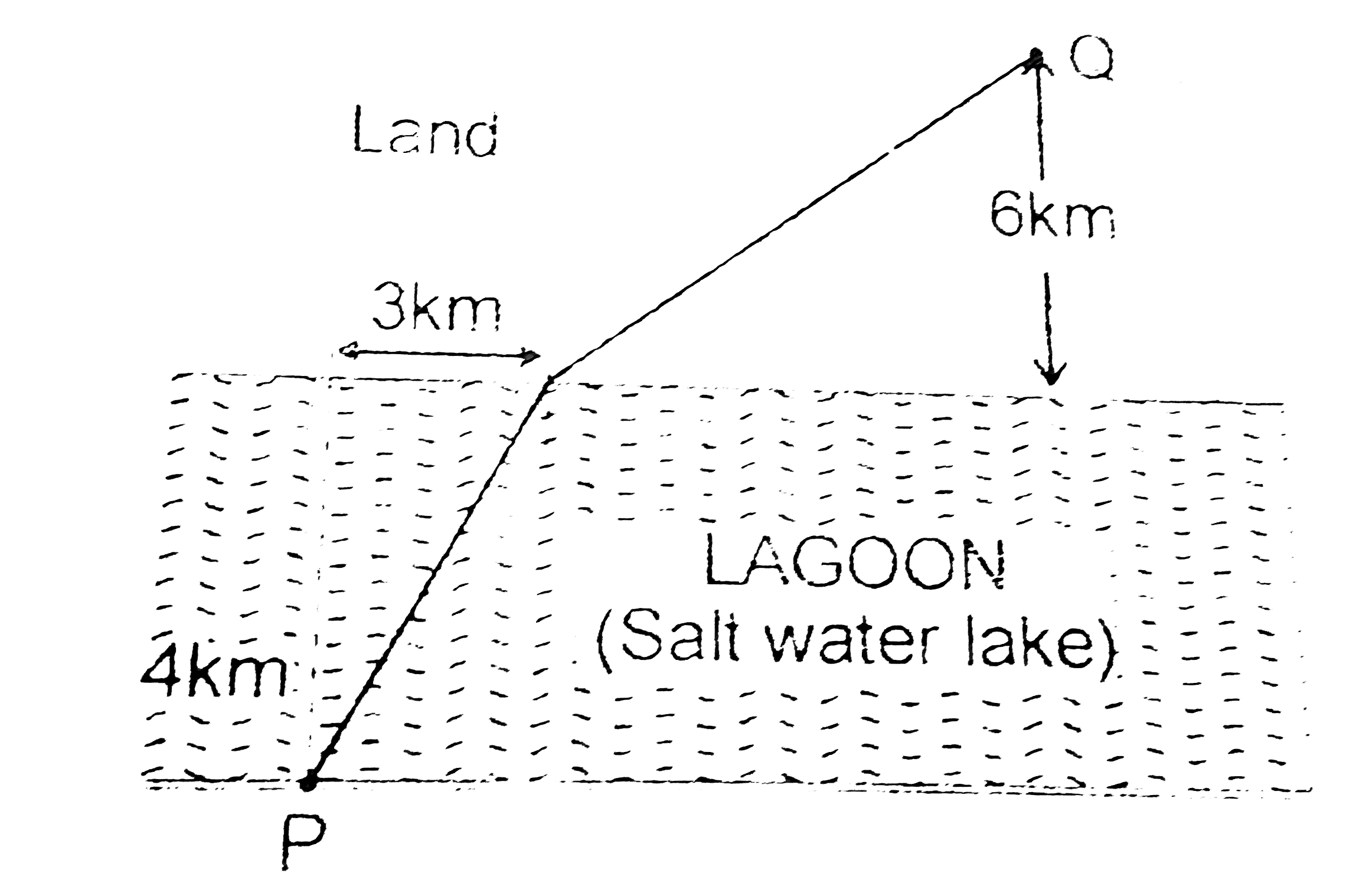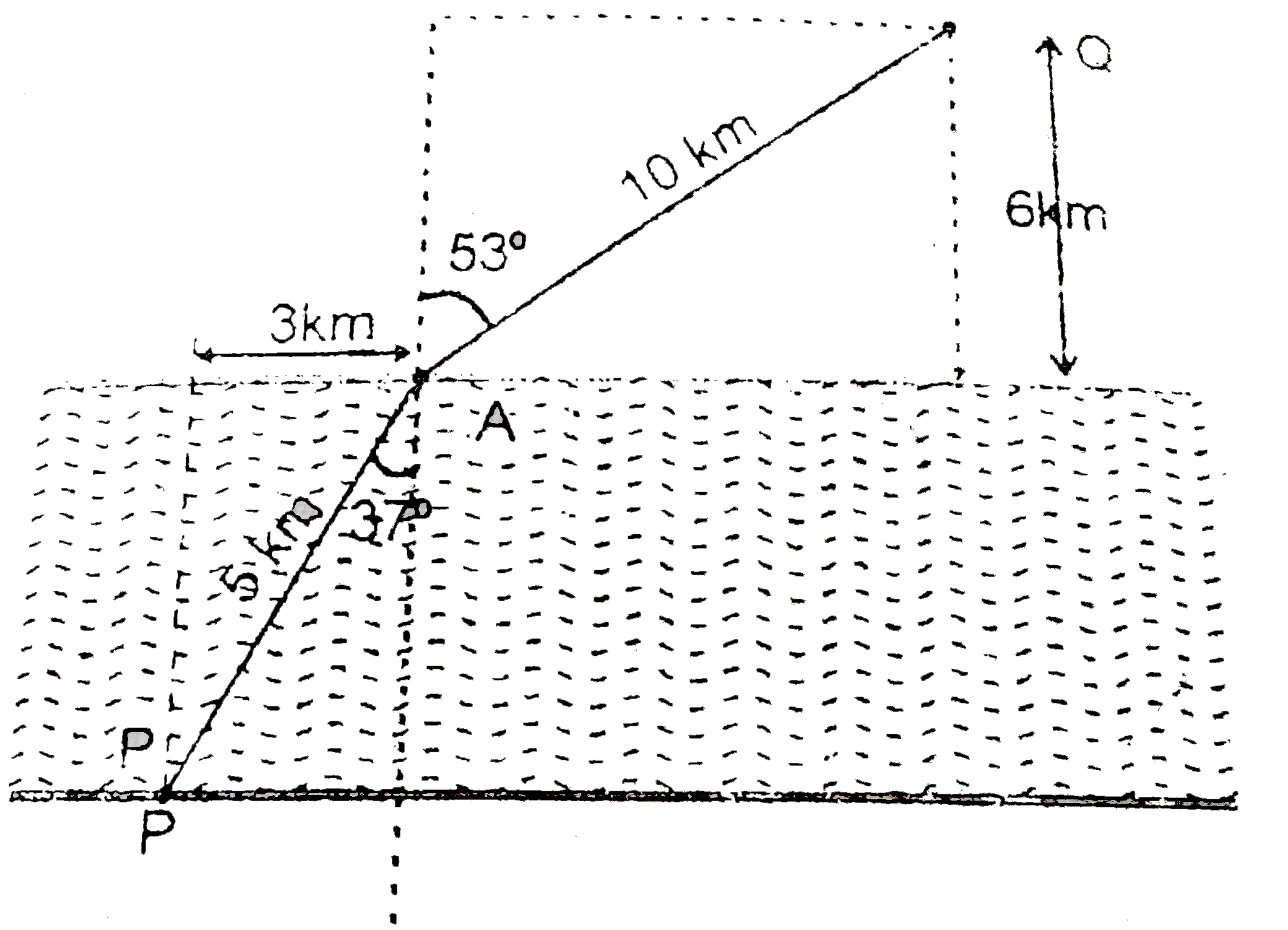A man starting from point P cross a 4km wide lagoon and reaches point Q in the shortest possible time by the path shown in the figure. If the person swims at a speed of 3km//hr and walks at a speed of 4km//hr, then find his time fo journey (in minutes).
 .
.
The correct Answer is:B

As we know that light travels in a path such as to reach from one point to another in shortest possible time.
Therefore, the man must travel along that path on which light would have travelled in moving from P to Q
By Snell's law
sinisinr=μ2μ1⇒sinr=μ1μ2,sini
sinr=35,43=45
⇒r=53∘
AQ=10km
From P to A :
t1=53
From A to Q:t2=104=52
T=t1+t2=53+52=256hr.=250 minutes.
Topper's Solved these Questions
- BOOK - RESONANCE ENGLISHCHAPTER - DAILY PRACTICE PROBLEMEXERCISE - DPP No.1320videos
DAILY PRACTICE PROBLEM
- BOOK - RESONANCE ENGLISHCHAPTER - DAILY PRACTICE PROBLEMEXERCISE - DPP No.149videos
DAILY PRACTICE PROBLEM
- BOOK - RESONANCE ENGLISHCHAPTER - DAILY PRACTICE PROBLEMEXERCISE - DPP No.1120videos
DAILY PRACTICE PROBLEM
- BOOK - RESONANCE ENGLISHCHAPTER - CURRENT ELECTRICITYEXERCISE - High Level Problems (HIP)19videos
CURRENT ELECTRICITY
- BOOK - RESONANCE ENGLISHCHAPTER - ELECTRO MAGNETIC WAVESEXERCISE - Exercise 327videos
ELECTRO MAGNETIC WAVES
Similar Questions
A man travels at a speed of 20 Km/hr. and then returns at a speed of 30 Km/hr. His average speed of whole journey is
View SolutionA swimmer S is in the sea at a distance d km from the closest point A on a straight shore The house of the swimmer is at a distance Lkm from A on the shore. He can swim at a speed of ukm/hr and walk at a speed of vkm/hr(v>u). At what point on the shore should he land so that he reaches his house in the shortest possible time?
View SolutionA person is standing at the edge of a slow moving river which is 1 km wide. He wishes to return to the camp ground on the opposite side of the river for which he may swim to any point on the opposite bank and then walk for the rest of the distance. The campground is 1 km away from the point on the opposite bank directly across from where he starts to swim. If he swims at the rate of 2 km/hr and walks at the rate of 3 km/hr, the minimum time taken by him is approximately 0.6 hr (b) 0.7 hr (c) 0.8 hr (d) 0.9 hr
View SolutionA man crosses the river in shortest time and reaches at an angle θ=60∘ to the direction of flow of water. If the speed of water is vw=4km/hr, find the speed of the man:
View SolutionArchit and Soha start from Point A in their respective cars. Archit reaches point B in 40 minutes and Soha reaches point B in 24 minutes. If Archit drives at an average speed of 45 km/h, find Soha's average speed and the distance between Points A and B.
View SolutionA man can swim in still water at a speed of 6 kmph and he has to cross the river and reach just opposite point on the other bank. If the river is flowing at a speed of 3 kmph, and the width of the river is 2 km, the time taken to cross the river is (in hours)
View SolutionA boat which has a speed of 5km/hr in steel water crosses a river of width 1km along the shortest possible path in 15minutes. The velocity of the river water in km/hr is
View SolutionA boat which has a speed of 5km/hr in steel water crosses a river of width 1km along the shortest possible path in 15minutes. The velocity of the river water in km/hr is
View SolutionThe time taken by a person to cover 150 km was 2.5 hrs more than the time taken in the return journey. If he returned at a speed of 10 km/hr more than the speed of going, what was the speed per hour in each direction?
View SolutionA man is walking on a level road at a speed of 3.0 km/h. Rain drops fall vertically with a speed of 4.0 km/h. Find the velocity of the raindrops with respect to the man.
View Solution

